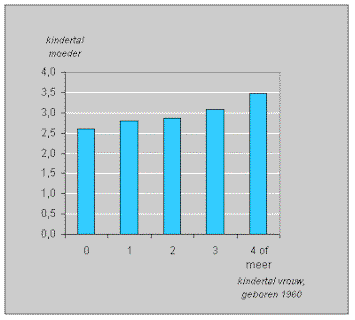Number of children: like mother, like daughter

Mothers and daughters show a clear correlation in terms of the number of children they have. If a mother has relatively many children, her daughters will too. If the daughter has relatively few siblings, she herself is likely to produce a relatively small family.
These are the results of an analysis of family sizes of women born between 1940 and 1970. For example, women born in 1960 who did not have children came from families that were on average one child smaller (2.6 children) than the families of women born in the same year who had four or more children (average 3.5 children).
Number of children of mother and daughters

Education, religion and age
Ultimate family size does not depend solely on the size of the family in which the mother was raised. Education and religion also play a part: the lower the education and the stronger the religious conviction, the more children a woman will have.
Lastly, the age at which women start having children is also an important factor. Women who have only one child have that child between 2.3 to 3 years later than women who ultimately have three or more children. The age at which women have their first babies has been increasing continuously since the 1970’s. Dutch women are now on average 29 when they have their first child. One reason for this relatively high age is that more women are staying in education, are staying in for longer, and then work for a number of years before starting a family.
Andries de Jong